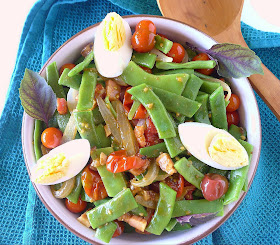You may be celebrating summer’s end with the Labor Day holiday, but here in southern Spain, I’m celebrating the end of the high season for tourists (hopefully, more parking spaces will be available in the village). And, I’m having a field day with garden vegetables.
A friend handed us a bag of cherry tomatoes from his garden. And my green beans are finishing, so it’s time to pick them all before they get too woody. The pods become progressively more fibrous and stringy as the “bean” inside the pods matures.
I’m making an old-fashioned Spanish vegetable dish, judías verdes con tomate—beans slow-cooked in tomato sauce—except that I’m cooking the beans just until crisp-tender and using cherry tomatoes for a quick “sauce.”
 |
| Cherry tomatoes make a savory sauce for snappy green beans. |
 |
| Served with crisp-fried potatoes and garnished with egg, the beans and tomatoes make a great lunch. |
The beans I grow are similar to what in the U.S. are called “Romano,” wide, flat pods. (One Spanish variety is the Garrofal, the bean added to classic Valencian paella.) But this recipe will work with all green beans—round-podded “string” beans, skinny haricots, wax beans as well as the flat ones. Any degree of mature is fine. Remove strings, if necessary. Cook them crisp-tender if they’re still small, but don’t be ashamed to cook big ole mature beans a long time, until completely tender.
Cooking time will depend on the variety and maturity of the beans. I find that round-podded snap beans take longer to cook than the flat Romano variety. Taste them while they’re cooking and take them off the heat when they’re done to your taste. Plunging the beans quickly into ice water will help keep their bright green color.
This dish can be served as a starter, side or light lunch dish. Turn it into a vegetarian entrée by omitting the optional bacon or ham. (If you're using ibérico ham, don't sauté it, but toss with the beans when you remove them from the heat.) Serve the beans hot, room temperature or cold. Cold, theyt are improved with a splash of vinegar or lemon juice right before serving.
Sauté of Green Beans and Cherry Tomatoes
Judías Verdes Salteadas con Tomates Cherry
Judías Verdes Salteadas con Tomates Cherry
Serves 4-6.
1 ¼ pounds green beans
¼ cup olive oil
2 cloves garlic, chopped
½ medium onion, cut in julienne
2 ounces diced bacon, pancetta or ham
8 ounces cherry tomatoes, halved
Salt
Freshly ground black pepper
Red pepper flakes (optional)
Pinch of cumin
Quartered hard-cooked egg, to serve (optional)
Fresh herbs to garnish
¼ cup olive oil
2 cloves garlic, chopped
½ medium onion, cut in julienne
2 ounces diced bacon, pancetta or ham
8 ounces cherry tomatoes, halved
Salt
Freshly ground black pepper
Red pepper flakes (optional)
Pinch of cumin
Quartered hard-cooked egg, to serve (optional)
Fresh herbs to garnish
 |
| Use a peeler to remove strings! |
 |
Get your beans in a row.
|
Remove strings from the beans, if necessary.
Cut off tops and tails. Cut the beans into 2-inch lengths. Bring a pot of salted water to a boil. Have ready a bowl of ice water. Add the beans to the boiling water and cook them to the desired degree of doneness--5-6 minutes for crisp beans, 10-12 minutes for well-cooked.
Lift the beans out with a slotted spoon or skimmer and drop them into the ice water. Allow the beans to cool. Drain them.
 |
| Tomatoes release their juices. |
Heat the oil in a large sauté pan or cazuela. Add the garlic. Before it browns, add the sliced onion and diced bacon. Sauté on medium heat until the onions begin to soften, 5 minutes. Add the tomatoes to the sauté pan. Fry them until they begin to release their juices, 3 minutes.
Add the beans to the pan and toss them with the tomatoes. Cook a few minutes so the flavors combine.
Serve hot, room temperature or cold, garnishing with quartered egg, if desired, and sprigs of fresh herbs.
 |
| Add any fresh herb to garnish the beans. I'm loving the purple basil. |
More recipes with green beans:









































